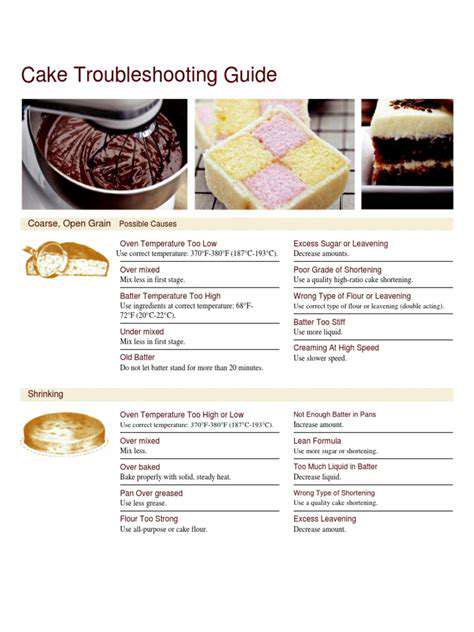Sheet Cake Baking Tips: Perfect for Parties
Baking Considerations for an Evenly Cooked Sheet Cake
Choosing the Right Pan
Selecting the appropriate baking pan is crucial for achieving an even bake in a sheet cake. A sturdy, well-greased pan that's just the right size prevents uneven heat distribution and ensures uniform rising. Metal pans like aluminum or steel work best because they conduct heat efficiently. While non-stick options exist, they sometimes cause uneven release - so test what works with your equipment.
Pan depth matters too. A moderately deep pan allows proper oven circulation, preventing dry centers and overcooked edges. Match the pan size to your recipe's volume - too small creates density, while oversized pans yield thin, uneven results. Always grease thoroughly or line with parchment to prevent sticking.
Mastering Oven Temperatures
Consistent oven heat makes or breaks sheet cake quality. Always preheat thoroughly and verify temperatures with a stand-alone thermometer - most oven dials aren't perfectly accurate. Fluctuations cause some areas to overcook while others stay doughy.
Airflow is equally important. Never overcrowd your oven - leave space around the pan for proper circulation. Position the rack in the center for even heat exposure. Opening the door frequently causes heat loss, so resist peeking until near the end of baking time.
Perfecting Baking Techniques
Even batter distribution prevents baking inconsistencies. Use a spatula to spread batter uniformly, eliminating lumps that create hot spots. For extra insurance, consider placing a baking stone on the oven's bottom rack to stabilize temperatures.
Timing checks require finesse. Insert a toothpick near the center when the timer nears completion - if it comes out clean, it's done. Overbaking dries out cakes, while underbaking leaves them unsafe. Follow recipe times as guidelines, adjusting for your oven's quirks.
Cooling and Decorating Your Sheet Cake for Party Display
Proper Cooling Methods
Cooling determines your cake's final structure. Transfer it to a wire rack immediately after baking - this prevents soggy bottoms from trapped steam. Never place hot cakes on countertops, as uneven cooling causes texture issues. Allow several hours for complete cooling before decorating.
Frosting Fundamentals
Frosting consistency makes all the difference. Buttercream should be soft enough to spread smoothly but firm enough to hold shape. Test a small amount first - if it runs or tears the cake, adjust the texture. Consider the party environment - warm rooms require sturdier frostings like Swiss meringue.
Decorative Touches
Elevate your cake with creative accents. Piped borders add polish, while fresh fruit provides color and freshness. Edible flowers make stunning natural decorations that impress guests. Arrange decorations to complement your party theme - geometric patterns for modern events or floral designs for garden parties.
Display Strategies
Presentation maximizes visual impact. Choose a sturdy cake stand that complements your decor. Position the cake where lighting highlights details, avoiding direct sunlight that melts frosting. For extended events, use a cake dome or refrigerate between servings to maintain freshness.
Troubleshooting Common Sheet Cake Baking Issues

Ingredient Solutions
Fresh ingredients are non-negotiable - stale baking powder or expired eggs ruin texture. Measure precisely using proper tools - guessing leads to density or collapse. Room-temperature ingredients incorporate better than cold ones.
Oven Adjustments
Inconsistent ovens create baking nightmares. Invest in an oven thermometer to monitor actual temperatures. Rotate pans halfway through baking if your oven has hot spots. Consider professional calibration if problems persist.
Mixing Methods
Overmixing develops gluten, creating toughness. Mix just until ingredients combine - a few small lumps are preferable to overworked batter. Follow recipe instructions for ingredient incorporation order.
Cooling Care
Rushed cooling causes structural issues. Allow cakes to cool gradually - sudden temperature changes promote cracking. Never frost warm cakes, as this melts the icing and creates a mess.
Pan Selection
The right pan prevents countless issues. Dark pans require reduced temperatures to prevent overbrowning. Glass pans retain heat longer than metal. Always use the size specified in recipes for proper rise and texture.
- Smart Food Storage: Keep Your Groceries Fresh Longer
- Simple Pasta Dishes: Weeknight Wonders
- Baking with Alternative Flours: Gluten Free and Beyond
- Keto Desserts: Guilt Free Sweet Treats
- Low Carb Breakfast Ideas: Keto Friendly and Satisfying
- Safely Defrosting Food: Best Practices to Prevent Bacteria
- Exploring Vietnamese Cuisine: Flavorful Soups and Noodles
- Low Calorie Desserts: Indulge Guilt Free
- Simple Salmon Patties: Quick and Healthy
- Authentic Italian Risotto: Creamy and Flavorful
- Exploring Chinese New Year Foods: Symbolism and Recipes
- Classic American Comfort Food: Hearty Chili Recipe